- CONDUCTING COLOURS
- See ‘colours 5)’.
- CONE TAPERED
- A simplified form of the Venetian entasis taper in which a flag pole tapers evenly from its
base to the truck – but see ‘Venetian entasis taper’
(also ‘flag pole’ and
‘truck’).
- CONFANONERIUS
- A medieval term, now obsolete, for a
‘standard bearer’.
- CONFANONUM (or CONFARONUM)
- A medieval term, now obsolete, for a ‘gonfanon’.
- CONJOINED (or CONJUNCT)
- 1) A heraldic term used when two or more charges are joined together so as to touch each
other - conjunct, or joinant (see also ‘charge 1)’).
- 2) See ‘interlaced’.




Flag and Emblem of the Army 2002 – 03, South Africa (fotw);
Flag and Arms of Šentilj, Croatia (fotw)
Please note – not to be confused with two sets of arms, or
elements from those arms, which are impaled by dimidiation – see
'dimidiated' and following note.
- CONOISSANSE
- See ‘cognisance’’.
- CONSECRATION
- The usually religious ceremony at which a new military or other ceremonial colour is
dedicated – a service or ceremony of consecration (see also
‘colour 2)’ and ‘parade flag’).
Please note that a ceremony of consecration – particularly that
of some non-military colours - may also include the honouring of an individual with the title
of God Parent to the flag involved - see ‘flag patron’).
- CONSTRUCTION SHEET
- See ‘specification sheet’.
- CONSULAR (CONSULAR OFFICER’S or CONSUL’S) FLAG
- See ‘diplomatic flags’.
![[UK consular flag]](../images/v/vxt-d568.gif)
![[UK consular flag]](../images/v/vxt-d568a.gif)
Consular Officer’s Flags Ashore and Afloat, UK (Graham Bartram)
- CONTINENTAL COLORS (or COLOURS)
- The first version of what later became the US national flag whose canton consisted
of the British 1606 pattern union jack rather than white stars on a blue field, and
in unofficial use from 1775 to 1777 – the grand (or occasionally “great”) union,
or Cambridge flag
(see also ‘Betsy Ross flag’,
‘British flag’,
‘Franklin flag’,
‘gridiron flag’,
‘old glory’,
‘quincunx’,
‘star-spangled banner’
and ‘stars and stripes’).

The Continental Colors, US (fotw)
- CONTOURNÉ
- See ‘Appendix V’.
- CONVENTIONAL FLAG
- See ‘hoisted flag’.
- CONVOY FLAG
- See ‘fanion 2)’.
- CORD
- 1) A length of decorative string or rope made from several twisted strands
with tassels at each end, generally made of silk (or a silk-like material) in
the livery or national colours (or gold/silver thread), simply knotted or tied
a bow at the centre and used to decorate a staff just below the finial (see also
‘finial’,
‘livery colours’,
‘national colours 2)’,
‘staff 2)’ and
‘tassels’).
- 2) As above but without tassels and used to finish the edges of a flag, usually
in the livery or national colours (or gold/silver thread).
- CORE FLAG
- The flag whose design forms the basis of other flags, or which inspired
the creation of other flags, with a typical two examples being the Arab revolt
flag of 1917 and the French tricolore (see
also ‘archivexillum’,
‘difference 1)’
‘flag family’, 'pan-African Colours',
'pan-Arab Colours' and 'pan-Slavic Colours').


Arab Revolt Flag 1917 and French Tricolore (fotw)
- CORNET (or CORNETTE or CORNUTE)
- 1) In largely British maritime usage a term, now increasingly obsolete, for
a small triangular pennant (see also 'pennant 2)').
- 2) In largely British RN and some other usage a term, now almost wholly obsolete,
for a swallow-tailed flag, particularly a signal flag (see also
‘signal flag’
and ‘swallow-tail(ed)’).
- 3) A 17th/18th Century generic term, now obsolete, referring to any small,
swallow-tailed flag.
- 4) An alternative form of ‘guidon’, now obsolete, as being the distinguishing
flag of a cavalry regiment (see also ‘guidon 2)’).
- 5) A term, now obsolete, for lowest commissioned rank in the cavalry regiments
of some countries (including those of the UK), being that rank responsible for
carrying the regiment’s cornet or guidon.
- CORNSHEAF
- See ‘garbe’.
- CORONATION FLAGS (or BANNERS)
- A term for those flags or banners (differing from the usual royal standard) which are prepared
specifically for display at the installation (coronation, swearing-in or simple inauguration) of a
monarch and often consisting of the relevant royal arms on a plain field – a “rijksvaandel”,
“riksbanner” or “banner of the realm” (see also ‘greater arms’
under ‘arms’ and ‘royal standard(s) 1)’).

Coronation Flags (riksbanner), Norway 1906 and 1818 (official website)
- CORONET
- 1) Generically on flags, a crown without a curved bar across the top that
may be seen in a wide variety of shapes and circumstances
(see also ‘antique crown’,
'civic crown',
‘crown’, 'mural crown' and
'naval crown').
- 2) Specifically on flags, the term may be used when a hereditary ruler is of a
lesser rank than that of crowned monarch - a princely or arch-ducal coronet (bonnet
or hat), or similar (see also ‘electoral cap’).
- 3) In English heraldry a crown without cross bar across the top as 1) above,
but also a symbol of nobility whose exact design is dependent upon the rank of
the person concerned (see also ‘mantle’).
![[coronet]](../images/v/vxt-d097.gif)
(Martin Grieve)
Please note that the use of a cross-bar across the
top to indicate royal status and to differentiate between a crown and a coronet
is of comparatively recent date.
- CORPORATE FLAG
- The distinguishing flag of a shore based commercial concern as opposed to
that of merchant marine company (see also
‘house flag 1)’ and
‘logo’).
![[Corporate flag]](../images/v/vxt-d582.gif)
Corporate Flag of Lufthansa, Germany (fotw)
- CORPORATION (or CORPORATE) BANNER
- In largely UK usage, a type of processional banner whose symbolism relates to the
corporate body of a town council or corporation, or to the community represented –
see ‘banner 3)’.
- CORSAIR ENSIGN
- See ‘privateer ensign’.
- COTTICE (COTISE or COST)
- See ‘appendix VII’ (also
‘cotticed 1)’ below).
- COTTICED (COTISED or COTIZED)
- 1) On flags, a term that may be used to describe the addition of one or more
narrow stripes or bands to an existing charge (such as a stripe or cross) but
which is separated from that charge by a strip of field - but see note below.
- 2) In heraldry the term has a rather more restricted/complex use which is
briefly described in Appendix VII, however, it is
suggested that a suitable glossary or dictionary of heraldry should be
consulted for further details.
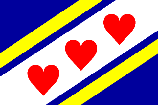


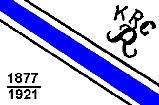
Flag of Svitavy Okres, Czech Republic (fotw);
Naval Ensign of Ukraine (fotw); Imperial War Flag 1903 – 1919, Germany (fotw); Flag of Koblenzer Rowing club, Germany (fotw)
Please note with regard to 1) that where the field is not shown between the charge
and the cottice (as illustrated below) it should be described as double or triple fimbriated as appropriate
(see also ‘fimbriation 1)’).

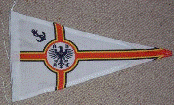
War Ensign of Germany 1938 – 1945 (fotw); Pennant of the Allgemeiner Deutscher Automobilclub, Germany (fotw)
- COUCHANT
- See ‘Appendix V’.
- COUNTER-
- The heraldic prefix used when two charges on a shield, banner of arms or flag are turned in contrary directions
as in “fleuri-counterfleuri” (see ‘double-tressure’), or when two
tinctures are reversed either side of a line or lines drawn through a coat of arms see
‘counterchanged’ (also
‘counterchanged cross’ in ‘appendix VIII’ and
‘counter-compony’).
- COUNTER-COMPONY
- An abbreviation of the heraldic term compony counter-compony used when an
ordinary or border is composed of two rows of squares (or occasionally
rectangles) in alternating tinctures – see ‘counter-’ above and
‘compony’
(also ‘checky 1)’,
‘checky 2)’,
‘counterchanged’ below,
‘ordinary’ and
‘tincture’).


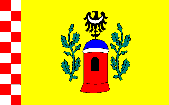
Flag of Olsberg, Switzerland (fotw): Flag of Niemcza, Poland (Jarig
Bakker): Flag of Calfreisen, Switzerland (fotw)
- COUNTERCHANGED (or COUNTER-CHANGED)
- (adj) A basically heraldic term used to describe two colours alternating either
side of a line or lines drawn through a flag or coat of arms or charge - parti-coloured
(see also ‘charge’,
‘coat of arms 2)’
‘counter-’,
’counterchanged cross’ in ‘appendix VIII’,
‘counter-compony’ above
and ‘faceted’).
![[counterchanged]](../images/v/vxt-d101.gif)
![[Greenland]](../images/v/vxt-d101a.gif)
![[Maryland, US]](../images/v/vxt-d101b.gif)
![[Tubise Belgium]](../images/v/vxt-d101c.gif)
From left: counterchanged example; Flag of Greenland (CS); Flag of Maryland, USA (CS); Flag of Tubize, Belgium (Ivan Sache)
- COUNTY FLAG
- See ‘sub-national flag’ (also
‘civic flag 2)’.
- COUPEAU
- A French heraldic term for the base of a shield, banner of arms or a flag that is composed of
semi-circular mounds, and is intended to represent (usually) three (but up to six) hills –
see ‘compartment’ (also ‘mount’).




Arms and Flag of Ludbreg, Croatia (fotw); Arms of Pope Paul VI (Modern Popes); Flag of Oberohrdorf, Switzerland (fotw)
- COUPEAU OF THREE (or OF FIVE)
- See ‘coupeau’ above.
- COUPED
- 1) The heraldic term used when a charge is cut off in a straight line as is often the case with the heads and
limbs of animals but see 2) below (also 'erased')..
- 2) A heraldic term that is also used when an ordinary or charge does not extend to
the edges of a shield or banner of arms, for example a cross-couped – but see
‘slipped’ (also
‘charge’,
‘cross-couped’ in ‘appendix VIII’,
‘Greek cross 2)’ and
‘ordinary’).

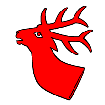

Unofficial Flag of Northern Ireland (fotw); Flag of Andwil, Switzerland (fotw); National Flag of Tonga (fotw)
- COURTESY FLAG
- That flag (normally, but not exclusively, the national flag of the country
being visited) flown from a prominent position on a merchant vessel as a matter
of courtesy when visiting a foreign port – a complimentary flag (see also
‘yardarm’).
- COVERING
- The term used when a canton obscures the entire width of a stripe or stripes on a multi-striped flag,
usually (but not invariably) at the hoist – for example, a square or rectangular canton covering the first
three stripes as shown below (see also
‘canton 2)’,
‘multi-stripe 2)’ and
‘multi-stripe 3)’).


National Flag of Togo (fotw); Flag of Goiás, Brazil (fotw)
Please note that this term is never used alone but always with the number of
stripes being covered.
- COWARD
- See ‘appendix V’.
- COWED
- See ‘queued’.




![[UK consular flag]](../images/v/vxt-d568.gif)
![[UK consular flag]](../images/v/vxt-d568a.gif)










![[counterchanged]](../images/v/vxt-d101.gif)
![[Greenland]](../images/v/vxt-d101a.gif)
![[Maryland, US]](../images/v/vxt-d101b.gif)
![[Tubise Belgium]](../images/v/vxt-d101c.gif)













![[coronet]](../images/v/vxt-d097.gif)
![[Corporate flag]](../images/v/vxt-d582.gif)